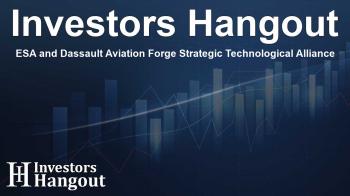ESA and Dassault Aviation Forge Strategic Technological Alliance

ESA and Dassault Aviation Forge Strategic Technological Alliance
The European Space Agency (ESA) and Dassault Aviation are embarking on an exciting collaboration that sets the stage for a technological partnership aimed at advancing space exploration. The two organizations have identified a shared interest in fostering mutual development, focusing primarily on technology progress in Low Earth Orbit (LEO) and operational capabilities related to orbital vehicles.
The Vision for Space Exploration
ESA is pursuing its ambitious strategy for continued space exploration through its initiative named Explore2040. The agency is actively seeking innovative solutions that can facilitate efficient travel to and from LEO, the Moon, and Mars. The goal is not just reaching these destinations, but ensuring safe and reliable missions supported by cutting-edge technologies, such as hypervelocity re-entry systems.
Advancing Reusable Space Technology
On the other hand, Dassault Aviation has a stellar reputation in aerospace engineering and has outlined its commitment to expanding its activities in space. The company is designing a reusable spaceplane that will utilize advancements from both aeronautical and space spheres. Their concept, known as “Véhicule Orbital Réutilisable de Transport et d'Exploration (VORTEX),” is being developed to facilitate a range of operations, including transporting cargo to space stations and offering various in-orbit services.
Strengthening European Space Capabilities
Josef Aschbacher, ESA's Director General, expressed his confidence in Dassault Aviation’s capabilities, stating, "Dassault Aviation’s decades of expertise in aeronautical and space systems position them perfectly to lead the development of critical space technologies. Through VORTEX, we aim to bolster European space capacity and secure sovereign access in an increasingly competitive environment." This sentiment is echoed by Eric Trappier, Chairman and CEO of Dassault Aviation, who reiterated the potential this collaboration holds for enhancing Europe’s technological sovereignty in the space sector.
Expanding Collaboration Opportunities
Both ESA and Dassault Aviation foresee significant benefits from their partnership, including joint risk reduction in technology development. They aim to explore opportunities in various areas related to LEO, including the design and testing of advanced materials and integration processes for space vehicles. Future payload assessments will also be key components of their collaborative framework.
Joint Efforts for Innovation
To realize these ambitious goals, the agreement will facilitate information sharing, studies, and preparatory work to define roles and responsibilities effectively. This cooperative effort seeks to leverage the strengths of both organizations, allowing them to advance together in this rapidly evolving industry.
Daniel Neuenschwander, ESA's Director of Human and Robotic Exploration, highlighted the importance of having a diverse and complementary skill set within Europe. "Expanding the European industrial base is crucial in unlocking new opportunities in space exploration and achieving greater autonomy for our endeavors," he noted.
About the Organizations
The European Space Agency serves as Europe’s premier gateway to space, established in 1975 with the overarching mission of optimizing the region's space capabilities for the benefit of its citizens. With 23 member states, ESA strives to facilitate collaboration across nations to undertake programs far surpassing what any single entity could achieve.
Dassault Aviation, established over a century ago, has delivered more than 10,000 military and civilian aircraft to over 90 countries. Known for its exceptional design and production of various aircraft, including the Rafale fighter jets and the Falcon business jets, the company remains a key player in the global aerospace sector, generating impressive revenues while maintaining a workforce of 14,600 employees.
Frequently Asked Questions
What is the purpose of the collaboration between ESA and Dassault Aviation?
The collaboration aims to advance technology development for space exploration, focusing on improving capabilities for missions to Low Earth Orbit and beyond.
What technologies will be developed through this partnership?
The partnership will focus on technologies such as hypervelocity re-entry systems, reusable space vehicles, and advanced materials for spacecraft.
How does VORTEX contribute to Europe’s space strategy?
VORTEX serves as a reusable spaceplane concept that will enhance Europe’s capabilities for cargo transport and in-orbit services, promoting autonomy in space operations.
What are the expected outcomes of the Letter of Intent?
The Letter of Intent facilitates collaboration on technology development while defining the roles of each organization in coordinated projects.
Why is this collaboration important for Europe?
This collaboration is crucial for strengthening Europe's position in the competitive global space sector, fostering innovation, and achieving sovereignty in space capabilities.
About The Author
Contact Owen Jenkins privately here. Or send an email with ATTN: Owen Jenkins as the subject to contact@investorshangout.com.
About Investors Hangout
Investors Hangout is a leading online stock forum for financial discussion and learning, offering a wide range of free tools and resources. It draws in traders of all levels, who exchange market knowledge, investigate trading tactics, and keep an eye on industry developments in real time. Featuring financial articles, stock message boards, quotes, charts, company profiles, and live news updates. Through cooperative learning and a wealth of informational resources, it helps users from novices creating their first portfolios to experts honing their techniques. Join Investors Hangout today: https://investorshangout.com/
The content of this article is based on factual, publicly available information and does not represent legal, financial, or investment advice. Investors Hangout does not offer financial advice, and the author is not a licensed financial advisor. Consult a qualified advisor before making any financial or investment decisions based on this article. This article should not be considered advice to purchase, sell, or hold any securities or other investments. If any of the material provided here is inaccurate, please contact us for corrections.

